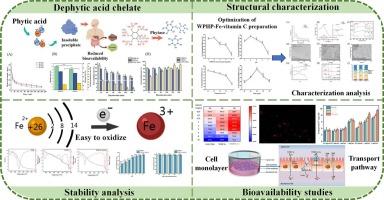核桃蛋白水解物铁-维生素C复合物的开发与表征:通过植酸酶辅助修饰提高铁的生物利用度
IF 9.8
1区 农林科学
Q1 CHEMISTRY, APPLIED
引用次数: 0
摘要
本研究以核桃蛋白为原料,分别用植酸酶和Alcalase对核桃蛋白进行处理,得到核桃蛋白水解物(WPHP)。植酸酶水解降低了植酸与铁的相互作用,暴露了肽结合位点,并使强铁螯合率达到80.78 ± 0.58 %。随后加入维生素C形成wphp -Fe-维生素C配合物,通过Fe-羧基和Fe-羰基配位和氢键稳定,并伴有结构重组。该配合物具有多孔结构,粒径为345.76 nm, pH为 7.0时溶解度为90.22 %,在不同的pH、离子和热条件下均稳定。与WPHP-Fe相比,该配合物具有更高的铁潴留。Caco-2实验表明,维生素C可减轻植酸的抑制作用,并显著增强DMT1途径对Fe2+的吸收,在120 min时达到9.47 ± 0.13 μg/孔。这些结果强调了植酸酶和维生素C的互补作用,并支持该复合物作为肽基铁补充剂。本文章由计算机程序翻译,如有差异,请以英文原文为准。

sDevelopment and characterization of a walnut protein hydrolysate-Fe-vitamin C complex: Enhancing iron bioavailability through phytase-assisted modification
In this study, walnut protein was treated with phytase and Alcalase to produce walnut protein hydrolysate (WPHP). Phytase hydrolysis reduced phytic acid‑iron interactions, exposing peptide binding sites and enabling strong Fe2+ chelation rate of 80.78 ± 0.58 %. Vitamin C was subsequently added to form WPHP-Fe-vitamin C complex, which was stabilized through Fe-carboxyl and Fe‑carbonyl coordination and hydrogen bonding, accompanied by structural reorganization. The complex exhibited a porous microstructure, particle size of 345.76 nm, solubility of 90.22 % at pH 7.0, and stabilized under varying pH, ionic, and thermal conditions. Compared with WPHP-Fe, the complex showed higher iron retention. Caco-2 assays revealed that vitamin C mitigated the inhibitory effect of phytic acid and significantly enhanced Fe2+ uptake via the DMT1 pathway, reaching 9.47 ± 0.13 μg/well at 120 min. These results highlight the complementary roles of phytase and vitamin C and support the complex as a peptide-based iron supplement.
求助全文
通过发布文献求助,成功后即可免费获取论文全文。
去求助
来源期刊

Food Chemistry
工程技术-食品科技
CiteScore
16.30
自引率
10.20%
发文量
3130
审稿时长
122 days
期刊介绍:
Food Chemistry publishes original research papers dealing with the advancement of the chemistry and biochemistry of foods or the analytical methods/ approach used. All papers should focus on the novelty of the research carried out.
 求助内容:
求助内容: 应助结果提醒方式:
应助结果提醒方式:


